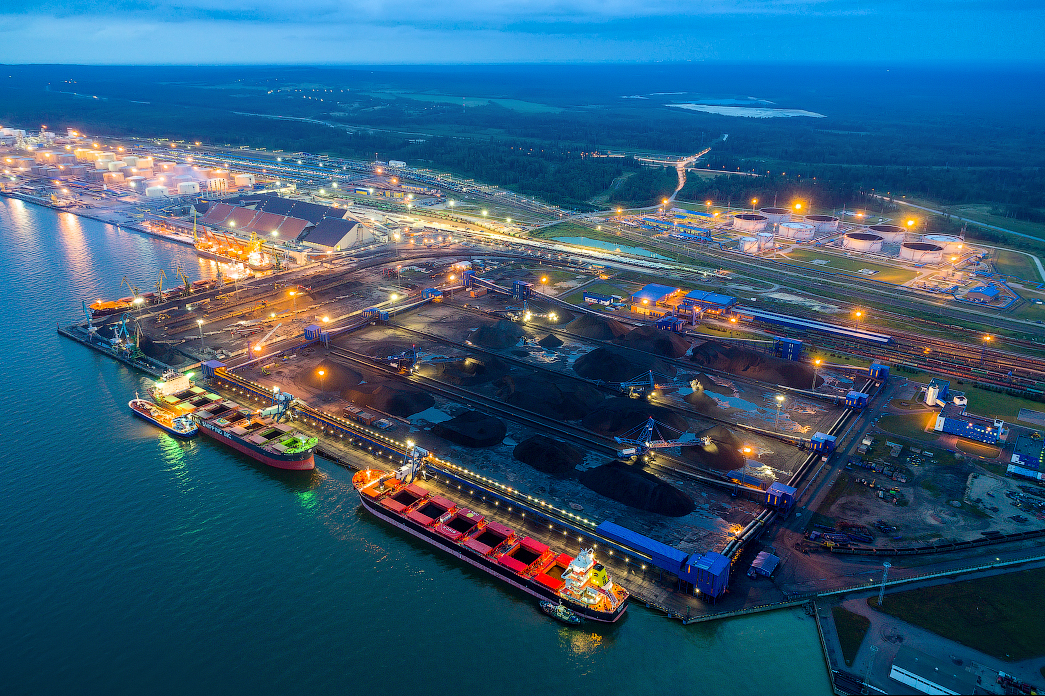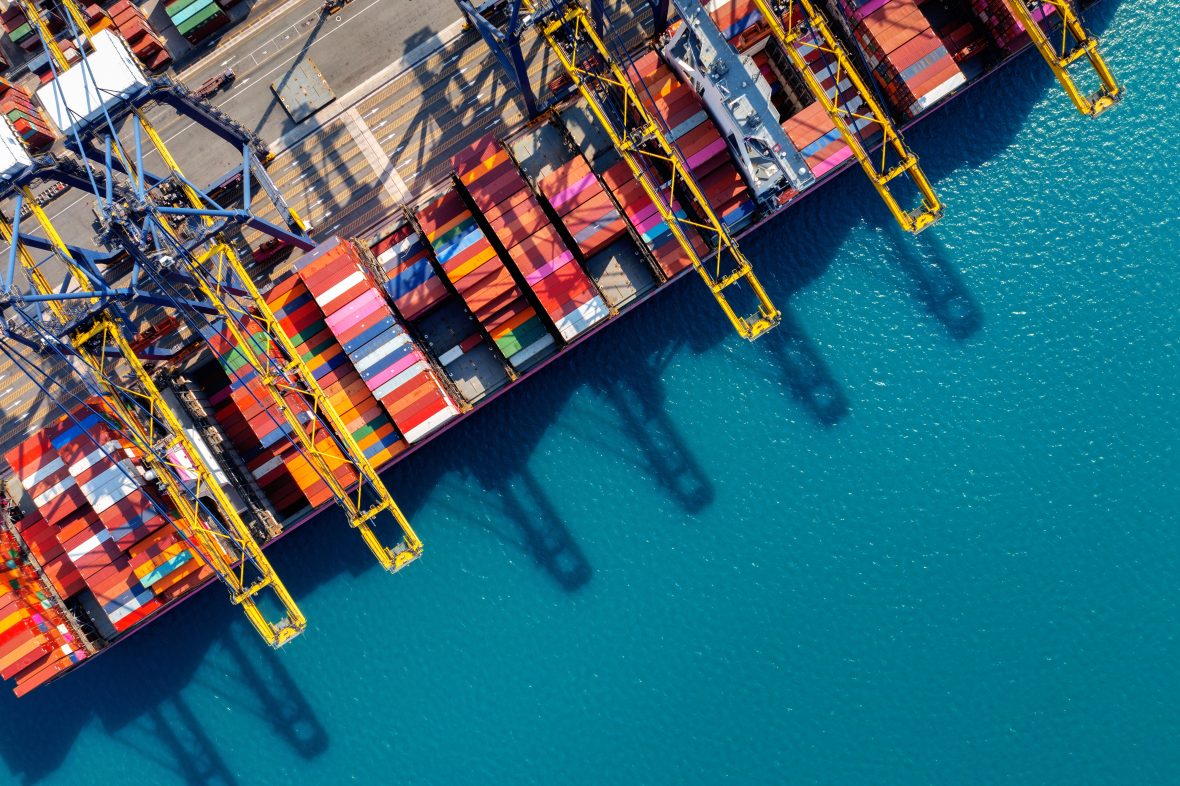Ust-Luga Port, Russia: Review, Characteristics, Prices

The commercial sea port of Ust-Luga is the largest universal port on the Baltic Sea and the second largest port in Russia after Novorossiysk.
It is in use all year round and has a short ice channeling period of 40 days. The port’s freight terminals and production complexes can handle and process more than 20 types of cargo.
Ust-Luga’s LOCODE is RUULU.
History

The port of Ust-Luga was built to expand port capacities in the northwest of Russia, which lost its harbors in the Baltics after the collapse of the Soviet Union. The construction began in 1993, with the first coal terminal opening for operation in 2001.
The ocean port is being developed by the Ust-Luga Company, which was specifically created to implement the project and manage it.
This was one of the first public-private partnership projects in new Russia to be successfully tested at a large scale.
Contacts
The freight port of Ust-Luga is located on both sides of the Luga River Kingisepp District, Leningrad Region (59° 43′ N, 28° 24′ E). This is about 130 km south of St.Petersburg, on the northwest coast of Russia.
Phone: +7 81 23341677
E-mail: info@ust-luga.ru
The port is being developed by the Ust-Luga Company, but each of its twelve terminals has its own operator and can be contacted separately.
Cargo turnover

According to the materials of the Baltic Sea Ports Authority, the cargo turnover in January-December 2021 in the port of Ust-Luga amounted to 109 million 377.2 thousand tons. This is 7% higher than during the same period of 2020.
Bulk cargo transshipment volume grew by 10% and amounted to 50 million 789.8 thousand tons. Transshipment increased by 11% and amounted to 42 million 14.7 thousand tons.
Liquid cargo transshipments rose from 4% on January-December 2020 to 56 074.100 tons in 2021, including oil rising by 5% to 23 223.200 tons, and oil product cargo rising by 4% to 32 254.800 tons.
Transshipments of general cargo rose by 12% to 781 600 tonnes.
Ferry transshipments grew by 9% to 1 139 500 tons.
Container port turnover decreased by 41% compared to January-December 2020 and amounted to 29 298 TEU.
Size
The commercial seaport of Ust-Luga spans an area of 2 610.34 acres, with its water area covering 26.08 square miles.
The seaport has short approach channels of 2.29 miles and 1.12 miles respectively, while the maximum water depth is 57.4 feet.
The number of berths: 38.
The total length of the quay front reaches 23 678.5 feet.
This is the only Russian port in Baltica that is capable of receiving heavy ships with a deadweight of up to 160 000 tons.
Ust-Luga’s Terminals

The general development plan of the commercial seaport entails building 16 terminals. By 2021, there were twelve terminals in operation there:
- The charcoal terminal operated by Rosterminalugol JSC.
- Car and railway portage complex, run by FSUE Rosmorport North-Western Basin Branch.
- Yug-2 multipurpose reloading depot, operated by OOO New Utility Technologies.
- Container station, run by Ust-Luga Container Terminal JSC.
- Sulfur depot. Operator: European Sulfur Terminal LLC.
- Universal freight terminal. Operator: Universalniy Reloading Complex LLC.
- Timber complex, run by Lesnoy Terminal Faktor OAO.
- Liquefied petroleum gas transloading complex. Operator: Portenergo LLC.
- A complex for transshipment of rolling cargo. Operator: Terminal Novaya Gavan OOO.
- Liquid cargo depot. Operator: Ust-Luga Oil JSC.
- Fractionation and transshipment complex for stable gas condensate. Operator – NOVATEK-Ust-Luga OOO.
- Oil transshipment complex. Operator: Nevskaya Pipeline Company OOO.
On May 21, 2021, Russia’s Gazprom, together with its project partner RusGazDobycha, started building an important new gas, chemical, and LNG complex. It is expected that this terminal will include a 13 million mt/year Baltic LNG plant and start producing gas in 2026.
Throughput

The seaport of Ust-Luga’s throughput capacity has reached 191 million tons and keeps rising.
Its very first terminal, a coal terminal managed by Rosterminalugol JSC, started working in Ust-Luga in 2001.
The regular shipments started in 2002 after the first line with the capacity of 4 million tons was put into operation. The complex of the second stage started working in 2006.
By 2007, the seaport of Ust-Luga had eight yards:
- A coal terminal.
- Lumber Terminal.
- Automobile and railway ferry complex.
- Yug-2 multi-purpose transshipment complex.
- Universal Transshipment Complex.
- Technical sulfur transshipment complex.
- Fish terminal.
- Vessel service terminal.
By 2011, three more were added:
- The rolling cargo terminal was put into operation.
- The liquid cargo terminal was put into operation “in test mode”.
- The container terminal (Ust-Luga Container Terminal OAO, owned by NKK) received its first ship.
In 2012, the seaport began shipping oil from the second Baltic Pipeline System (BPS-II). The throughput capacity of the first stage of BPS-II reached around 30 million tons of oil per year.
In June 2013, SIBUR and NOVATEK launched LPG and stable gas condensate transshipment terminals, respectively.
In January 2016, cargo turnover reached 7.3 million tons, which was 3.9% higher than 2015’s figures for the same period
The port’s cargo turnover growth was largely due to the overflow of transit traffic previously directed to the Port of Tallinn, whose cargo turnover fell by 20% in 2015 alone.
The commercial sea port of Ust-Luga has been particularly active in the transportation of automobiles, fuel oil, and containers, with the ports of Primorsk and Ust-Luga being the main habs for oil transport from Russia.
At the same time, coal handling has the biggest share within the port – it takes about 37% of all stevedoring work.
While Russia is the main exporter of coal through the harbors of the Eastern Baltic region, Ust-Luga is the largest coal handling port among them. In 2020, it handled over 37,791.800 tons of such cargo.
Why Credo Trans Works With Ust-Luga
There is a number of reasons to work with Ust-Luga:
- The delivery of cargo through Ust-Luga is cheaper than through the ports of Latvia, Estonia, Lithuania, and Finland.
- There are no delays in cargo handling, typical for the high season.
- No passenger traffic that would delay cargo ships.
- It is a freightliner port – the Ust-Luga railway hub is already one of the largest in the North-West of Russia. A significant part of the port’s cargo turnover is delivered by railway.
- There is a good road connection via M-11 Narva Highway.
- It has a modern engineering communications system – power, potable and domestic water supply, telecommunications.
Comparing the characteristics, the reason becomes clear.
| Ust-Luga | St.Petersburg | Riga |
| Short approach channels of 2.29 miles and 1.12 miles. | The length of the sea channel: 16.77 miles. | The length of the sea channel: 13.67 miles. |
| Depth: 57.4 feet. | Depth: 36.08 feet. | Depth: 22.96 – 36.08 feet. |
| Width: 590.55 feet. | Width: 262.46 – 492.12 feet. | Width: 328.08 feet. |
| Two directional traffic. | One directional traffic. | One directional traffic. |
| No passenger ships. | Priority of passenger ships. | Priority of passenger ships. |
| Ice period: 4 months. | Ice period: 6 months. | Ice period: 4 months. |
Advantages of Working With Ust-Luga

Located at the intersection of North-South (Baltic, Black, and Caspian Seas) and East-West (Europe-Asia) intermodal transport corridors, the commercial sea port of Ust-Luga organically fits into the transport network of the North-Western region and the European transport infrastructure.
Territorial proximity of the European Union and Central Russia makes it attractive for the export of Russian goods.
Another competitive advantage of Ust-Luga port is its year-round operation with a short (only four months) ice-breaking period.
The Ust-Luga seaport has a large water area depth (57.4 feet) in combination with short approach channels (2.29 miles and 1.12 miles).
The port can handle any heavy-tonnage tankers (up to 160 thousand tons deadweight), which are able to pass through the Danish straits at the entrance to the Baltic Sea on their draught, as well as receive ocean-going Ro-Ro ships of any type.
Two approach channels allow for circular vessel traffic.
Its road and railroad external communications bypass the overloaded St. Petersburg transport hub thus ensuring fast cargo delivery.
The number of berths, channels, and waterways, length of ice period, supply chain connections all impact a dwell time – the length of time a ship spends in a port.
The longer the dwell time, the more expensive it is for the shippers and ship operators.
The shorter it is, the fewer additional charges all sides need to pay, along with facilitating reliable Just-in-Time (JIT) procurement and manufacturing operations of importers.
Terms and pricing policy of Ust-Luga
In accordance with the Russian Federation’s regulations, the seaport of Ust-Luga levies the following port dues:
- Ship toll.
- Channel fee.
- Pilotage toll.
- Lighthouse fee.
- Navigation toll.
- Environmental charges.
- Icebreaker toll.
- FSUE “Rosmorport” (North-West Basin Branch) levy for transport safety of seaport waters.
- Investment toll.
The tolls and fees are available at FSUE “Rosmorport” (the Russian Federal State Unitary Enterprise that develops and maintains sea transport infrastructure).
Main Routes To Other Countries

The Ust-Luga is a part of commercial transport routes that connect some of the ports of the Baltic Sea, as well as ports of countries outside of it.
Sea container lines in the port of Ust-Luga:
- HAPPAG LLOYD.
- CMA CGM.
- MAERSK.
- UNIFEEDER.
- X-PRESS FEEDERS.
There is also a ferry line connecting Klaipeda and Ust-Luga.
Along with the sea lines, the cargo to and from this commercial seaport is transported by rail and road, with some oil and gas coming through the pipeline.


